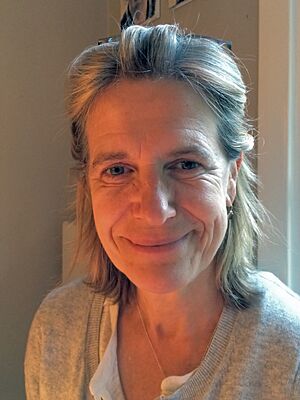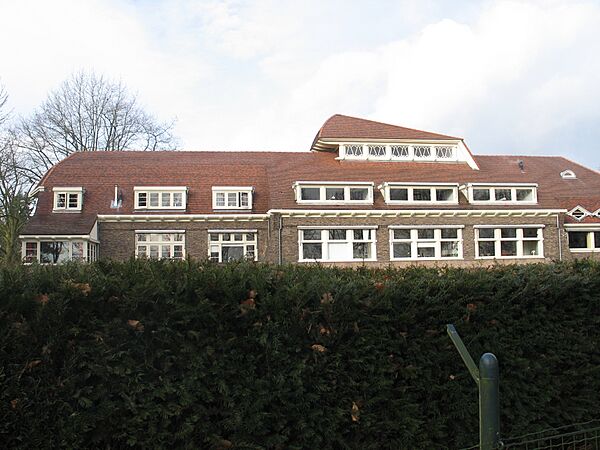Wageningen facts for kids
Quick facts for kids
Wageningen
|
|||
|---|---|---|---|

Wageningen market square
|
|||
|
|||
| Motto(s):
City of Life Sciences
|
|||

Location in Gelderland
|
|||
| Country | Netherlands | ||
| Province | Gelderland | ||
| City right | 12 June 1263 | ||
| Government | |||
| • Body | Municipal council | ||
| Area | |||
| • Total | 32.36 km2 (12.49 sq mi) | ||
| • Land | 30.49 km2 (11.77 sq mi) | ||
| • Water | 1.87 km2 (0.72 sq mi) | ||
| Elevation | 9 m (30 ft) | ||
| Population
(May 2014)
|
|||
| • Total | 37,434 | ||
| • Density | 1,228/km2 (3,180/sq mi) | ||
| Demonym(s) | Wageninger | ||
| Time zone | UTC+1 (CET) | ||
| • Summer (DST) | UTC+2 (CEST) | ||
| Postcode |
6700–6709
|
||
| Area code | 0317 | ||
Wageningen is a city and municipality in the central Netherlands. It is located in the province of Gelderland. The city is well-known for Wageningen University, which focuses on subjects like life sciences.
In 2014, Wageningen had a population of 37,434 people. Many thousands of these are students from over 150 different countries.
Contents
People of Wageningen
Most people living in Wageningen are Dutch. A good number of residents also come from other countries.
Where is Wageningen Located?
Wageningen is on the north side of the Nederrijn river. This river is part of the Lower Rhine in the Netherlands. The city is also near the Gelderse Vallei and the Veluwe areas. A hill called the Wageningse Berg is in the southwest of the Veluwe.
You can reach Wageningen by car using highways A12, A15, and A50. If you travel by train, you can go to the Ede-Wageningen railway station. From there, a 20-minute bus ride will take you to the city center.
Wageningen's Past: A Look at History
The first known settlements in the Wageningen area were north of today's city. People mentioned them as early as the year 828. In the early Middle Ages, a small church was built on a hill east of the town. Old wooden farms have been found near the top of this hill.
In the 12th century, people started living where Bergstraat is now. A stone floor from this time has been found near Hotel de Wereld. The oldest part of the current city was built to the south. This happened after a dike was built to protect the city from water. Later, parts of the city north of the Hoogstraat were built.
Becoming a City
Wageningen officially became a city in 1263. A city wall and a moat protected it. In 1526, a castle was built. The castle was taken apart in the 18th century. However, you can still see the foundations of three towers and part of the wall today.
Wageningen During World War II
The people and buildings of Wageningen suffered a lot during World War II. The center of Wageningen was destroyed by bombs in May 1940. This happened soon after the German army invaded the country.
Wageningen is also famous for its role at the end of the war. On May 5, 1945, the German commander, Johannes Blaskowitz, surrendered here. He surrendered to the Canadian commander, Charles Foulkes. This event officially ended the war in the Netherlands. The generals talked about the surrender terms in the Hotel de Wereld. This hotel is near the city center.
Liberation Day Celebrations
Every year on May 5, the Netherlands celebrates Liberation Day. Wageningen hosts a big festival on this day. Veteran soldiers march through the city and are honored for their service. About 120,000 people visit the music stages around the city.
Learning and Research in Wageningen
In 1918, Wageningen got its first university, the Landbouwhogeschool Nederland. This university was based on an older agricultural college from 1876. It later became Wageningen University. This was the start of Wageningen changing from a small historic town into a modern science hub. This change is still happening today.
Wageningen University and Research Centre (WUR) is a major employer. It has about 7400 people working there.
Wageningen is also the main city in Food Valley. This is a group of food and nutrition companies and research centers. Food Valley is thought to be the largest food and nutrition research area in the world. For example, Keygene, a plant research company in Wageningen, helped develop a method called AFLP. They also worked with the Beijing Genomics Institute to study the full genetic code of a plant called Brassica napus.
Sports in Wageningen
Wageningen used to have its own professional football (soccer) club, FC Wageningen. The club won the KNVB Cup twice. However, the club closed down in 1992. Their last game was in May 1992 against NAC Breda.
The city is also home to the biggest Korfball club in the country, KV Wageningen.
Getting Around Wageningen
Wageningen is located on the N225 provincial road. This road connects to Driebergen and Arnhem. The N781 road links Wageningen to the A12 national highway. A small ferry crosses the Nederrijn river south of the city at Lexkesveer. From there, you can reach the A15 national highway.
Several companies offer public bus services in Wageningen. From the central bus station, you can take buses to many nearby towns. These include Rhenen, Tiel, Veenendaal, Utrecht, Oosterbeek, and Arnhem. You can also take a bus to the Ede-Wageningen railway station. From Ede-Wageningen station, you can connect to other buses. These buses can take you to places like the Hoge Veluwe National Park and the Kröller-Müller Museum.
Here are some of the bus lines available:
| Line | Route | Carrier | Details |
|---|---|---|---|
| 44 | Wageningen – Rhenen NS – Kesteren NS – Lienden - Maurik - Tiel NS | Arriva | |
| 45 | Wageningen – Rhenen NS – Kesteren NS – Ochten - Tiel NS | Arriva | |
| 50 | Wageningen – Rhenen Station NS – Els – Amerongen – Leersum – Doorn – Driebergen-Zeist NS – Utrecht CS | Connexxion | |
| 51 | Wageningen – Renkum – Heelsum – Doorwerth – Heveadorp – Oosterbeek – Arnhem CS | Breng | |
| 352 | Wageningen – Renkum – Heelsum – Oosterbeek – Arnhem CS | Breng | |
| 53 | Wageningen – Renkum – Heteren – Driel – NS Station Arnhem Zuid – Winkelcentrum Kronenburg | Breng | |
| 80 | Wageningen – Rhenen Station NS – Veenendaal centrum – Veenendaal de Klomp NS – Renswoude – Scherpenzeel – Woudenberg – Leusden – Amersfoort CS | Connexxion | |
| 84 | Wageningen – Wageningen Campus – Gelderse Vallei Ziekenhuis – Ede-Wageningen NS | Syntus Gelderland | Part of the Valleilijn |
| 86 | Wageningen – Bennekom – Ede-Wageningen NS | Syntus Gelderland | |
| 88 | Wageningen – Wageningen Hoevestein - Gelderse Vallei Ziekenhuis – Ede-Wageningen NS | Syntus Gelderland | Part of the Valleilijn |
| N52 - Night bus | Arnhem Willemsplein – Wageningen | Breng | Only Saturday night |
Famous People from Wageningen
Many interesting people have lived in or are from Wageningen:
- Johannes de Raey (1622–1702) was a Dutch philosopher.
- Gerrit Zegelaar (1719–1794) was a Dutch painter.
- August Falise (1875–1936) was a Dutch sculptor.
- Li Edelkoort (born 1950) is a Dutch trend forecaster for fashion and design.
- Eline Flipse (born 1954) is a film director known for documentaries.
- Alexander Pechtold (born 1965) is a politician who used to be the local Mayor.
- Jeroen Dijsselbloem (born 1966) is a Dutch politician and economist. He studied at Wageningen University.
- Lisa Hordijk (born 1987) is a Dutch singer who won the TV show X Factor.
- Nikkie de Jager (born 1994) is a famous Dutch makeup artist and beauty vlogger. She also co-hosted the Eurovision Song Contest 2021.
Sports Stars from Wageningen
- Aletta van Manen (born 1958) was a field hockey player. She won a gold medal at the 1984 Summer Olympics.
- Ed van Es (born 1959) was a water polo player who competed at the 1984 Summer Olympics.
- Annelies Maas (born 1960) is a freestyle swimmer. She won a bronze medal at the 1980 Summer Olympics.
- Jacqueline Toxopeus (born 1964) was a Dutch field hockey goalkeeper.
- Bart Voskamp (born 1968) is a retired road bicycle racer.
- Annemiek van Vleuten (born 1982) is a Dutch road racing cyclist.
- Botic van de Zandschulp (born 1995) is a Dutch tennis player. He reached the quarterfinals of the 2021 US Open.
Places to Visit in and Around Wageningen
There are many interesting places to see in Wageningen and nearby:
- International Club Association
- Airborne Museum 'Hartenstein' in Oosterbeek
- Botanical Gardens in Wageningen
- De Casteelse Poort Museum
- Het Depot Museum
- Hoge Veluwe National Park in Ede
- Hotel de Wereld
- Kröller-Müller Museum in Ede/Otterlo
- Netherlands Open Air Museum in Arnhem
- Ouwehands Zoo in Rhenen
- Wageningen University Campus
Sister Cities
Wageningen has two sister cities:
The city also has special project connections with Zhangzhou, China, and Ndiza, Rwanda.
Images for kids
-
Panorama of the Rhine river in Wageningen
See also
 In Spanish: Wageningen para niños
In Spanish: Wageningen para niños
















